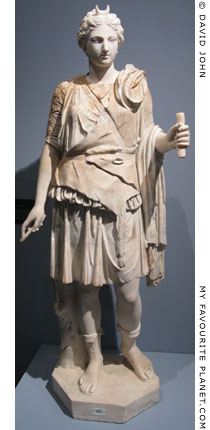|
|
|
| My Favourite Planet > English > Middle East > Turkey > Selçuk > photo gallery 2 |
| Selçuk gallery 2 |
Ephesus Museum, Selçuk |
 |
 |
1 of 10 |
 |
 |
|
| |
|
Statue of the goddess Artemis, known as the "Beautiful Artemis Ephesia", 125-175 AD. |
| |
|
| |
The Ephesus Archaeological Museum in Selçuk (Turkish, Efes Müzesi) is reputed to be one of Turkey's finest small museums, and it is easy to see why. It has exhibits that cover every phase of Ephesus' history from archaic times to the Ottoman period. The museum itself seems to be constantly developing, as new exhibits are added and the way in which they are displayed and lit are improved. The designers have made great use of limited space, and for those with even only a slight interest in history it is a fascinating show.
The museum is now open again, having been closed 2012-2014 for extensive refurbishment and the addition of a new extension.
Outside there is a garden with a café for history-overloaded, foot-weary visitors. |
|
|
| |
| The Beautiful Artemis Ephesia statue |
| |
See larger close-up photo below.
The museum's main attraction, of course, is the astounding marble statue of the fertitlity goddess Artemis (Greek, Αρτεμις), known as the "Beautiful Artemis Ephesia", considered to be the most beautiful of three on display (see the photo of the "Great Artemis", the other large statue of the goddess in the museum, right).
Altogether four cult statues of Artemis Ephesia were found by Austrian archaeologists in 1956 in the Prytaneion at Ephesus. [1] Although none of the statues are quite 2000 years old, having been made during Roman Imperial period in the first or second century AD, they are thought to be copies of a much more ancient cult statue, perhaps of wood, from the Great Temple of Artemis.
Ancient writers such as Pausanias refer to a wooden cult statue of Artemis set up by the Amazons in an age long before the Ionian Greeks arrived here. The Roman architect Vitruvius wrote that in his time, the first century BC, the statue of Artemis in the temple was made of cedar wood. [2]
This type of Artemis is known as "Artemis Polymastros", the many breasted (there 26 on this statue), although some experts believe that the many protuberances on her chest may be eggs, large amber beads or testicles of sacrificial bulls.
They are quite unlike the classical Greek and Roman statues we are used to seeing, with their emphasis on the human form, movement, the folds of clothing and ideal geometric proportions (see a photo of a more typical Graeco-Roman statue of Artemis below). This Artemis, standing rigidly upright and covered with images of animals and other symbols, has something more ancient and oriental about her. Whether the copies we see today are faithful to the older originals, or remodelled to suit contemporary Graeco-Roman taste is unknown. Several copies of the statues have been discovered in territories of the Roman Empire. [3]
Artemis Ephesia ("The Beautiful Artemis").
Ephesus Archaeological Museum, Selçuk.
Inv. No. 718. Height 174.5 cm.
The "Great Artemis" (right) wears a high mural crown (corona muralis) symbolizing Ephesus, topped by a model of the Artemis Temple.
See also a modern copy of the "Great Artemis" statue,
which stands in a fountain in the centre of Selçuk,
on Selçuk gallery 1, pages 29-30. |
|

The other large Artemis statue
in the Ephesus Museum,
known as the "Great Artemis".
Height 292 cm. Inv. No. 712. |
|
| |

A close-up of the Beautiful Artemis Ephesia statue. |
| |
The epiphet "beautiful" is quite fitting for this statue, particularly the face of the goddess, which shows her feminine strength, resoluteness and serenity. The marble and workmanship are of excellent quality, and the intricate details are superb. The overall effect of the figure is uncanny, fascinating, and quite alien to most modern western viewers.
Artemis has five fabulous winged beasts kneeling on either side of her coiled headdress, and six rows of three kneeling beasts (including lions, oxen and lionesses or panthers) down the front of her tight, tapering skirt below the "breasts". Mythological figures stand within the garland around her neck, below and around which are signs of the zodiac.
Two lions stand passant [4] on the outside of each upper arm, and around each of her wrists she wears a coiled band with ends in the form of facing lionesses' heads. On the side of each leg is a vertical series of panels containing figures: a winged female (Nike?), a rosette and a bee. Each figure appears twice in sequence.
The skirt flares out at the ankles, rather like roots of a tree; at the front her toes are exposed, and her feet are close together. This part of the statue appears to have been made in a separate piece, which is missing from the "Great Artemis".
At either side of the goddess stands a deer, one of her companion animals.
Unfortunately, since the statue is displayed in a niche close to the wall, it is difficult to view the side of the figure and impossible to see her back. |
| |

A coin from the reign of Hadrian (117-138 AD) showing
the statue of Artemis Ephesia in the Artemision.
John Turtle Wood, Discoveries at Ephesus, page 266.
Longmans, Green and Co., London, 1877.
See a photo of a similar coin on the History of Ephesus page. |
|

A marble statue of Artemis
the huntress (Ἄρτεμις
Ἀγροτέρα, Artemis Agrotera),
made in a style more familiar
to the Greeks and Romans.
In her left hand she held a
bow, in the right an arrow.
Marble, 125-150 AD after a
4th century BC prototype.
Pergamon Museum, Berlin. |
| |

A Roman copy of the Artemis
Ephesia statue. Marble, with
bronze head, hands and feet.
Height 115 cm.
Palazzo dei Conservatori,
Capitoline Museums, Rome.
Inv. No. MC1182.
Another fine Roman copy of
the statue, dated to the 2nd
century AD, is in the National
Archaeological Museum,
Naples Inv. No. 665. |
| |
| |
Ephesus
Museum
Selçuk |
Notes, references and links |
 |
|
1. Discovery of the Artemis statues in the Ephesus Prytaneion
Credit for the discovery of the statues in 1956 is usually given to the Viennese archaeologist Franz Miltner (1901-1959), who was director of excavations at Ephesus from 1956.
| • |
The "Great Artemis", thought to be from the reign of Trajan (98-117 AD), was found in the courtyard of the Prytaneion, where it once stood. |
| • |
The "Beautiful Artemis", from the reign of Hadrian (117-138 AD) or early in the reign Antoninus Pius (138-161 AD), was found carefully buried in a side room (No. 5). |
| • |
The "Small Artemis", of the mid-Antonine period, is from the vestibule of the Stoa, and a copy of it was found in the courtyard. |
See Franz Miltner, Ephesos. Stadt der Artemis und des Johannes. F. Deuticke, Vienna, 1958.
2. Vitruvius on the statue in the temple at Ephesus
Vitruvius (circa 80-15 BC), a Roman architect and engineer, known only as the author of the book De Architectura (On architecture), dedicated to Emperor Augustus (reigned 27 BC - 14 AD).
As a Roman, Vitruvius naturally refers to Artemis as Diana. He also mentions that the coffered ceilings of the temple were made of cedar wood. Cedar was expensive in antiquity and prized for its properties which made it suitable for sculpture and fine architectural work.
"The cedar and the juniper tree have the same uses and good qualities, but, while the cypress and pine yield resin, from the cedar is produced an oil called cedar-oil. Books as well as other things smeared with this are not hurt by worms or decay. The foliage of this tree is like that of the cypress but the grain of the wood is straight. The statue of Diana in the temple at Ephesus is made of it, and so are the coffered ceilings both there and in all other famous fanes [temples], because that wood is everlasting. The tree grows chiefly in Crete, Africa, and in some districts of Syria."
Vitruvius, The ten books on architecture, Book II, chapter 9, Timber, section 13. Translated by Morris Hicky Morgan and Albert A. Howard. Harvard University Press and Oxford University Press, 1914. At Project Gutenberg.
3. Roman copies of the Artemis statues
Examples include those still in situ at Hadrian's Villa at Tivoli, near Rome, and at the Villa of Herodes Atticus in Loukou, Arkadia, Peloponnese, Greece (now in the Astros Museum, see Athens Acropolis gallery page 32). Copies can also be seen at several museums, including the Capitoline Museums, Rome (see photo right), the Vatican Museums, Rome, the National Museum in Naples and the Skulpturensammlung, Dresden, Germany.
4. Lions passant
In heraldry, a standing lion with a front paw extended is referred to as passant or passant guardant. |
|
|
Map, photos and articles: © David John,
except where otherwise specified.
Additional photos: © Konstanze Gundudis
All photos and articles are copyright protected.
Images and materials by other authors
have been attributed where applicable.
Please do not use these photos or articles without permission.
If you are interested in using any of the photos for your
website, project or publication, please get in contact.
Higher resolution versions are available on request. |
|
| |
 |
Visit the My Favourite Planet Group on Facebook.
Join the group, write a message or comment,
post photos and videos, start a discussion... |
|
|
| |
|
|
|